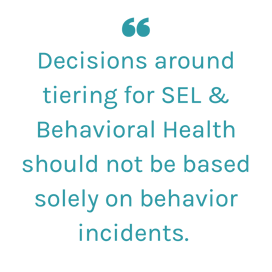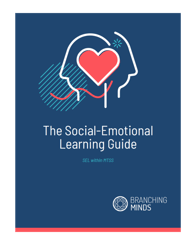As schools and districts make the shift to include social-emotional learning (SEL) within their overarching MTSS practice, we often get questions about where student behavior fits into this framework. Many educators still view SEL and Behavioral Health as separate areas, but what’s more problematic is when these two areas are not aligned.
|
Key points of this article:
|
This is the case when schools that have made efforts to promote social-emotional learning through evidence-based practices and programs still use punitive disciplinary approaches in reaction to student misbehavior. But more often, school and district leaders want to make sure they clearly communicate the differences and similarities between expectations around social-emotional learning and behavior-based approaches to their staff and students.
Below we answer some common questions about bridging the gap between SEL and behavior-based approaches in MTSS.
1. Are SEL and PBIS Compatible?
By definition, SEL is focused on teaching and promoting student skills, knowledge, and attitudes. SEL helps students develop healthy identities, manage their emotions, achieve personal and collective goals, feel and show empathy for others, establish and maintain supportive relationships, and make responsible and caring decisions.
PBIS is centered on proactive classroom and school practices to promote positive behaviors. The good news is that these two frameworks are compatible and have very similar overarching goals.
Similarities and differences between SEL and PBIS
- Primarily, SEL and PBIS can be used as complementary Tier 1 school and classroom-wide frameworks.
- Schools using an SEL curriculum can also set clear expectations and goals related to student behavior. For more information on integrating school-wide SEL and PBIS, check out this article from CASEL.
- Both SEL and PBIS can also help support students who are displaying behavioral or social-emotional difficulties. Using positive behavioral approaches can be especially effective when working with students who need additional support for their self-management and responsible decision-making skills.
- Students who are struggling socially (social awareness, relationship skills) may benefit more from programs and practices focused on building these competencies, such as mentoring groups, the Harmony SEL program, or a social skills program.
- Students struggling with self-awareness may need a combination of PBIS and SEL.
In summary, the actual approach used to support students should be based on the specific skills that teachers want to further develop and promote.
➡️ Learn more: The Alphabet Soup of Behavior Support
2. How Should Behavior Incident Data Be Used in MTSS To Support SEL?

One of the first steps in effectively using behavior incident data is to understand its limitations. Unfortunately, there are often biases in behavior incident reporting. Not only are certain students more likely to have behavioral referrals based on their demographic background, but some teachers are more likely to report behavior incidents compared to others.
This discrepancy could be more of a reflection of teachers’ skills and competencies rather than students. This is why decisions around tiering for SEL & Behavioral Health should not be based solely on behavior incidents.
Becoming aware of these limitations can help teams use behavior incident data more effectively.
For example:
Looking into the demographic breakdown of behavior incidents could let educators know if there is a problem with disproportionality in incident reporting based on race, ethnicity, special education status, or other sociodemographic variables.
It can also help school leaders identify areas where teachers need more support for classroom management practices. The data can also help behavior and SEL teams identify areas for school or classroom-wide Tier 1 programs and practices.
For example:
If there are high rates of peer conflict, an SEL program focused on social awareness and relationship building might be a good Tier 1 approach.
➡️ Related resource: Best Practices for Assessing Students' Social-Emotional Competencies within an MTSS Framework
3. What Are the Differences Between Behavior Assessments and Social-Emotional Assessments?
In general, behavior-based assessments will ask more questions about problematic classroom behaviors that may be linked to externalizing or internalizing symptoms.
Social-emotional assessments that are completed by teachers and parents often include questions about students’ behavior alongside questions about student social skills and emotions. This is because we often infer students’ social and emotional skills through the behaviors they present in the classroom.
Social-emotional assessments that are completed by students themselves will often ask them about certain thoughts, feelings, or attitudes. Importantly, social-emotional assessments will provide results that are tied to specific social-emotional domains, such as self-awareness, self-management, and relationship skills.
➡️ Related resource: Best Practices on Interpreting Student Assessment Data in MTSS
Using behavior assessments and social-emotional assessments in MTSS
When using either type of assessment in MTSS, what’s important is making sure that the assessments are reliable and valid so that the results are both informative and actionable. In other words, the data should help inform next steps across all tiered levels of support, whether that is helping support students’ behaviors, social-emotional competencies, or both.
Educators should also be careful not to conflate the behavioral assessment results with students’ overall social-emotional skills.
For example:
A student who is exhibiting behavioral problems in the classroom can also have social-emotional strengths. In some cases, having knowledge of both strengths and challenges can help develop a much more holistic intervention and prevention plan.
For more information about SEL assessments, check out this blog.
4. How Should We Progress Monitor Behavior and SEL?
In MTSS, progress monitoring is recommended across all topic areas for students receiving Tier 2 or 3 support. However, progress monitoring for SEL & Behavioral Health is slightly different from academic areas.
Short-term progress monitoring should be focused on explicit student behaviors. The key part of this process is identifying which behaviors to measure. Sometimes assessment data can help educators hone in on specific behaviors.
For example:
If an SEL assessment identifies a student as needing support with their social awareness skills, teachers working with the student can then focus on measuring student behaviors that are aligned with that skill (e.g., acting respectively towards peers, cooperating with peers). Once the behaviors are identified and clearly defined, teachers can track their frequency (for more information on behavior progress monitoring, check out this webinar).
Teachers can also use SEL assessments to conduct long-term progress monitoring. For example, The DESSA can be completed three times across each school year to measure social-emotional growth. It typically takes 60-90 days for students' overall social-emotional skills to change in response to an intervention such that you would see a difference in SEL assessment scores.
This is why you wouldn’t use this assessment on a weekly basis. In addition, these assessments typically ask teachers to reflect on student behavior over the past few weeks, which wouldn’t make sense to have teachers do weekly. So in an effort to protect teachers’ time, these types of SEL assessments should only be done once every 3-4 months for progress monitoring purposes.
➡️ Related resource: Integrating SEL Into an MTSS Framework: Resolving Four Common Problems
Schools Don't Need to Choose Between Supporting Students’ Social-Emotional Learning and Behavioral Health
In reality, it can be very difficult to separate student behavior from their social-emotional competencies. This is why having an integrated approach to promoting positive behaviors and social-emotional learning is essential.
Understanding social-emotional and behavioral strengths and needs will provide educators with a holistic understanding of their students as well as allow for more streamlined decision-making and problem-solving in MTSS.
Interested in Learning How to Support the Whole Child with Branching Minds?Branching Minds makes MTSS easy, efficient, and effective by bringing together all of the components of MTSS so teachers can collaboratively problem-solve and support all students’ holistic needs. Our system-level solution helps schools improve students’ outcomes across academics and behavior. Our platform supports teachers with Behavior and SEL in the following ways: ✅ Assessing SEL Needs with the DESSA
✅ Understand Students Perception of their Own SEL Competence with the SECA ✅ Leveraging SEL Screeners for Tiering ✅ More effective problem-solving ✅ Finding the Right Evidence-based Interventions & Accommodations for Each Learner ✅ Creating Intervention Plans and Monitoring Daily & Weekly Progress in Behavior/SEL ✅ Logging & Monitoring Behavior Incidents ✅ Pattern Matching Behavior Incidents Across Groups
|

About the author
Dr. Essie Sutton
Essie Sutton is an Applied Developmental Psychologist and the Director of Learning Science at Branching Minds. Her work brings together the fields of Child Development and Education Psychology to improve learning and development for all students. Dr. Sutton is responsible for studying the impacts of the Branching Minds on students’ academic, behavioral, and social-emotional outcomes. She also leverages MTSS research and best practices to develop and improve the Branching Minds platform.

Your MTSS Transformation Starts Here
Enhance your MTSS process. Book a Branching Minds demo today.


















.png?width=716&height=522&name=Addressing%20Foundational%20Reading%20Skills%20in%20MTSS%20(preview).png)
.png?width=716&height=522&name=Understanding%20Literacy%20Basics%20(Preview).png)
